


China Urban Planning Academic Season is an online academic brand organized by the Urban Planning Society of China (UPSC) from September 16 to 26, 2020. In this year, the Academic Season triggered a boom in online academic exchanges in China through 86 online academic activities.
Introduction
On the afternoon of September 22, 2020, the academic seminar "Urban and Rural Heritage Protection in Flooding - Ideas for Post Disaster Heritage Restoration " was held online and offline by the Academic Committee of Historical and Cultural City Planning of UPSC and organized by the Institute of Historical and Cultural Cities of China Academy of Urban Planning & Design. Professor Wu Qingzhou was invited to deliver an academic speech.
Original author: Wu Qingzhou

Wu Qingzhou
Member of the Academic Committee of Historical and Cultural City Planning of UPSC
Professor and doctoral supervisor of School of Architecture, South China University of technology
01 Ten functions of ancient Chinese water system and its crucial role in flood control and drainage
From the beginning of site selection and construction, an ancient city of China has attached great importance to water system, including lake and river. By establishing its own water system, a city could organically combine with water system to form a unified organism. The most critical experience of ancient Chinese cities in preventing waterlogging is to build a perfect urban water system and form a crucial infrastructure to avoid flooding. It is composed of the surrounding moat pond, rivers and lakes inside and outside the city. It has various functions and is known as "the blood of the city".
1.1 Site selection of ancient city and water system
Hydrophilicity is a universal law of ancient city site selection. Most of the famous ancient cities in China were distributed along river and lake. In this way, a city can obtain water benefits and effectively avoid water damage. For instance, the Tianjin Acropolis, built in the second year of Yongle in the Ming Dynasty (1404), was located in the only high area near Shanchakou, which not only made full use of the favorable conditions of water transport, but also reduced the threat of floods (Figure 1)。 Panyu ancient city, the predecessor of Guangzhou City, was built no later than the Warring States period. Its site is located in the Fanshan Mountain, where Ganxi River flows through the city. Due to its higher location and less flood tide, as well as the advantages of river and sea navigation, it has finally become the largest city in South China after more than 2,000 years of development (Figure 2)。
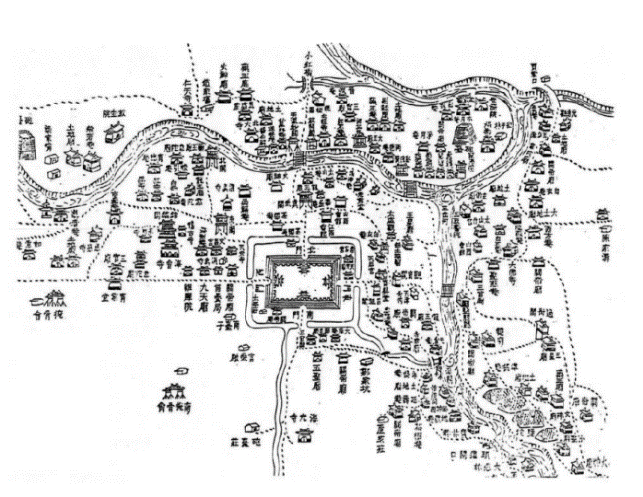
Figure. 1 Tianjin Chengguo Map
(Source: Tianjin Baojia Painting)
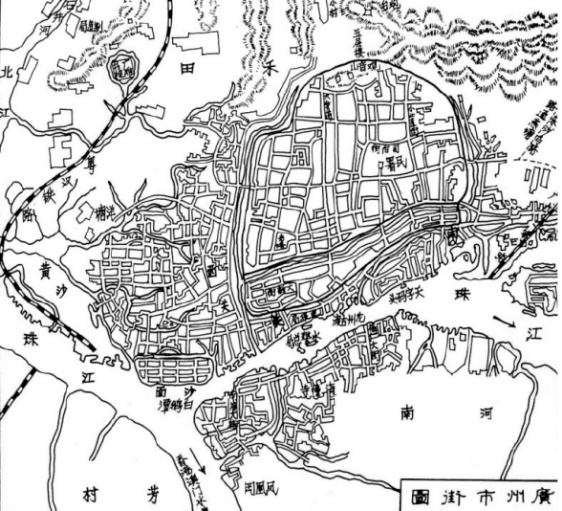
Figure 2 Guangzhou City Map of the Republic of China
(Source: Guangzhou Chronicle by Shi Cheng et al.)
1.2 Ten functions of urban water system
In summary, the water system in ancient China plays ten roles: water supply, transportation, irrigation and aquaculture, military defense, flood drainage, flood storage, fire prevention, wind and waves evasion, landscaping and water entertainment as well as urban environment improvement. Because of the above ten functions of urban water system, the ancients figuratively compared it to "the blood of the city".
1.3 The water system of ancient Chinese cities is a significant infrastructure to avoid waterlogging
Among the ten functions of urban water system, drainage and flood storage are particularly crucial for flood control. In ancient China, urban infrastructure was often referred to as "city - pool", emphasizing water systems such as canal, river and lake as critical infrastructure. The ancient city should combine these elements to build a connected canal system inside, and link to the outside with the natural water system ditches, so as to form a water system planning layout mode of "surrounded by moat, crossed by river channels and scattered by lakes and ponds". This system could regulate and store flood water and drain it into rivers.
The natural river system outside the city plays the role of "flood discharge"; The river and canal system inside the city divides the city into several drainage districts, to achieve the goal of "four directions can be discharged, nearby to accept (water)", and also increases the capacity of water storage. The lakes and ponds in the city break up the whole system into parts and store water in different areas. Ancient cities respect and protect the natural water system, regarding it as the "blood stream". Their water systems play the role of "discharge and storage at the same time", and construct into a multi-level integrated flood control and drainage system (Figure 3 & 4)。

Figure 3 Ganzhou City (1872), Heze City (1960) and Anyang City (1933)

Figure 4 Jingzhou City (1880), Nanyang City (1870) and Kaifeng City (1898)
(Source: Local Chronicles)
To a certain extent, urban construction in contemporary China neglects the protection of water system and destroys the function of this infrastructure. On the one hand, urban construction occupied or squeezed the river, so that the river level rise, make drainage difficult and increase the risk of waterlogging; On the other hand, water bodies and depressions such as urban rivers and lakes are filled, which makes the urban water system lack the function of regulating and storing water. Therefore, severe waterlogging after rainstorm is common in cities at present.
By analyzing the regulation and storage capacity of ancient urban rivers and canals, and converting it into rainfall afterwards, it could be found that the protection of urban rivers, lakes and surrounding greenery and other open Spaces can effectively store flood, prolong the drainage time in the case of short high-intensity rainstorm, and greatly reduce waterlogging.
02 Historical experience of water system construction and management in ancient Chinese cities
Based on the study of ancient capital cities, including Chang'an City of Tang Dynasty, the Dadu City of Yuan Dynasty and Forbidden City of Ming and Qing Dynasties etc, the following crucial findings are made.
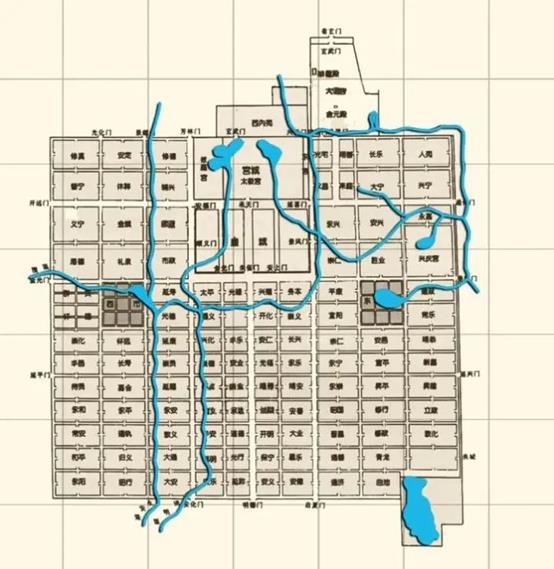
Figure. 5 Plan of Chang'an City in Tang Dynasty
(Source: Geography of Xi 'an City,1988)
(1)The density of urban flood discharge channel and flood discharge section are two critical technical indexes, which are essential for preventing waterlogging.
There are some mistakes in the planning and design of flood drainage system in Chang'an city of Tang Dynasty. While the Forbidden City in the Ming and Qing Dynasties is the most perfect model for the planning and construction of drainage system among ancient cities in China. Its density of flood channels reaches 8.3km/km2, which is 18.4 times that of Chang'an City in Tang Dynasty.
(2) The regulation and storage capacity of urban water system is a key factor to prevent waterlogging in the city.
The function of urban water system is worth paying attention to. Whether the urban water system has enough storage capacity is the key factor to avoid waterlogging. This scientific principle also has important reference value to the modern city flood control.
(3) Vital importance must be attached to the management of urban water systems.
In the past, the Forbidden City dredged ditches every spring. This system was formed in Ming Dynasty and was still in use in Qing Dynasty. It made the drainage system operate smoothly, and effectively played the role of drainage as well as flood discharge.
03 A model of water system construction in ancient Chinese cities: The Forbidden City
In the urban drainage system of Beijing during the Ming and Qing Dynasties, the most elaborate and scientific part was the drainage system of the Forbidden City. Since the completion of the Forbidden City in the 18th year of Yongle (1420), the city was surrounded by a moat and traversed by the Jinshui River, which were about 6 km in total.
The Forbidden City's drainage system is not only scientific and accurate in design and construction, but also well managed. In the past 600 years, there has been no record of disaster caused by rain, and the drainage system is still in use. This is not only a miracle in the history of China's urban construction, but also in the history of the world's urban construction.
The Palace City was built on the basis of Dadu City of Yuan Dynasty. At that time, the officials and artisans in charge of planning well comprehended the origin and development of the drainage system of the river system, as well as the drainage slope and elevation of the drainage ditches. In a word, in the construction of the Forbidden City, they made full use of the original drainage system and made improvements on it.
First, they dug a wide and deep moat around the city, as well as the Jinshui River, which was the city's main water supply and drainage channel. In terms of surface drainage, artisans skillfully use the terrain to make water flow down the slope to the open channel and converge together. And the water leaked into the ditch via the "eye money" afterwards. In the Ming Dynasty, the corners of the wall and the ditch were intersected with neat stones to make ditch sides and ditch covers. In Ming Dynasty, the drainage system was built neatly, and the slope was accurate. Tens of thousands of meters of pipeline, passing through many courtyards, can still achieve the effect of no silt after rain. In a nutshell, the design and construction of the Forbidden City's drainage system are impressive.
04 Another model of ancient Chinese water system: Fushougou Ditch, Ganzhou City
4.1 The dangerous terrain and severe flood in Ganzhou City
Ganzhou City is located in the subtropical monsoon climate zone, where the precipitation is concentrated in spring and summer, with an average annual precipitation of 1494.8mm. The ancient city is located at the intersection of Zhang and Gong rivers and surrounded by water on three sides. The tough terrain made Ganzhou acquire superiority of military defense as well as the convenience of land-water transportation. However, it brought severe flood threat to the ancient city at the same time. During the rainy season every year, the upper Gankang and Yudu basins collect rainwater from the mountains and flow into Ganzhou along the Zhang and Gong rivers.
In order to prevent flood and waterlogging, the ancient city wall of Ganzhou in Song Dynasty was transformed into masonry structure, and the part of the city wall along the river is still preserved. In addition, Ganzhou also established the urban drainage and storage system of "Zhang/jiagong rivers (section around the city) -- trench -- Fushou ditch -- pond", which became another model of urban water management in ancient China.
4.2 Terrain and drainage/storage mechanism of Ganzhou
(1) Planning and layout of reserving land for flood storage
The construction land in the ancient city of Ganzhou was reasonably arranged. The main public buildings in Song Dynasty were distributed in the first and second terrace along the ridge line. Meanwhile, the construction of residential buildings in the city is relatively restrained and does not occupy the depressions and ponds.
Ganzhou City has formed a water system with considerable capacity of storage and regulation by relying on “city moat - Fushougou Ditch - pond- depression”, which reduced the pressure of drainage in case of large amount of rainfall. In extreme cases, when the flood of Zhangjiang and Gongjiang rivers was close to the city and the rainwater could not be drained out, the function of this system would be more prominent.
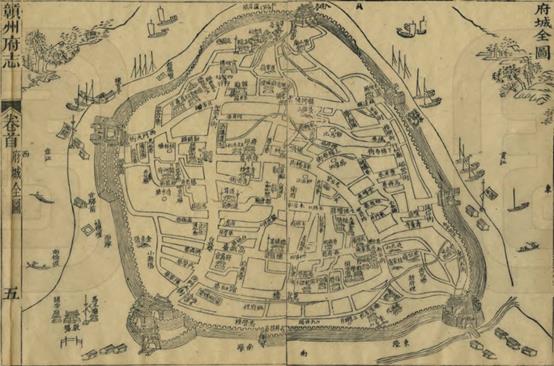
Figure. 6 Map of Ganzhou City
(Source: Chorography of Ganzhou Prefecture in Tongzhi period)
(2) The drainage system of " city moat - Fushougou Ditch - pond "
Fushougou Ditch is a large-scale ancient masonry drainage system under the ancient city of Ganzhou. It relies on the topography to integrate with the pond water system in the city, then connected to the moat and river outside the city wall by a one-way water window, forming a reliable one-way drainage and flood storage system.
The working principle of Fushougou Ditch can be demonstrated as "light rain accumulation, heavy rain discharge, and rainstorm storage". If the rain is light, the pond accumulates rainwater, and the urban water is sufficient. In ordinary heavy rain, if the level of river water is lower than that in the city, the Fushou Ditch could directly discharge the rain. When the rainstorm flood comes, which makes the river water higher than the depression in the city, the Fushougou Ditch system can prevent the river water from flowing backward by one-way water window. Meanwhile, it can effectively store rainwater to relieve the drainage pressure. After the rain flood, the river water drops, and Fushougou Ditch can quickly drain the waterlogging outside the city through the water window.

Figure. 7 Pond

Figure. 8 Trunk ditch
(Source: self photography)
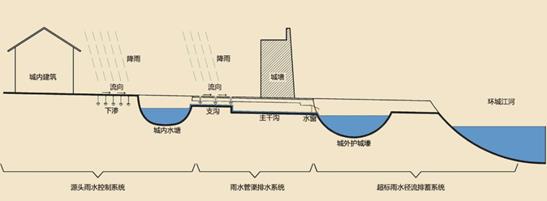
Figure. 9 "Fushougou ditch" drainage and storage system, Ganhou
(Source: self painted)
05 conclusion
While connecting with the natural water system, the ancient city of China constructed an urban water system of "moats around the city, rivers through the city, and ponds scattered in the city”。 In a rainstorm, the rainwater would either seep into the ground naturally, flow into the city's canals and ponds, or drain into the surrounding moat pools and flow into natural rivers. The construction experience of ancient urban water system in China, such as the Forbidden City and "Fushougou Ditch" in Ganzhou, represents a natural water management concept and construction mode of urban flood control as well as water resources utilization. This has precious practical enlightenment and reference significance for the planning and design of "sponge city".
The original text of the report is in Chinese. According to the contents of the report, it is sorted out and posted on the official website of UPSC. All figures come from the screen capture of the online activities. Some of the contents have been adjusted in translation.